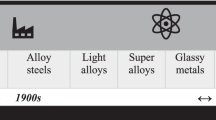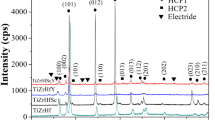Conclusions
-
1.
An increase of the manganese content of alloys of the system Mn−Al−C from 68.9 to 73.5% increases the stability of the high-temperature ε-phase, and as a result of cooling in air from the homogenization temperature the ε-phase becomes fixed in the structure.
-
2.
An increase of the manganese content of alloys of the system Mn−Al−C also lowers the temperatures of the beginning and end of the ε→τ-transformation and at the same time broadens its temperature interval.
-
3.
Enrichment of alloys of the system Mn−Al−C with aluminum or manganese relative to the optimal composition leads to the appearance of excess nonmagnetic η- and β-phases, respectively, and these lower the level of magnetization; in addition to that, in the alloy with 73.5% Mn thermal stability is impaired as a result of disintegration of the ferromagnetic phase.
-
4.
A small amount of η-phase (up to 15%) lowers the deformability of the alloy, which manifests itself in higher yield stresses and lower ductility, but when the alloy contains the same amount of β-phase, it leads to a considerable lowering of the yield stress.
Similar content being viewed by others
Literature cited
H. J. Kono, "On the ferromagnetic phase in manganese-aluminum," J. Phys. Soc. Jpn.,13, 1444–1451 (1958).
T. Kubo. T. Ohtani, S. Kojima et al., Machinable Anisotropic Permanent Magnets of Mn−Al−C Alloys. United States Patent 3, 976, 519 (1976).
W. Crunberg and M. Jentzsch, "Beitrag zur Metallkunde ferromagnetischer Mn−Al−C Legierungen," Neue Hütte,4, 150–155 (1986).
L. S. Shur, G. S. Kandaurova, N. N. Bykhanova, and N. I. Sokolovskaya, "On the magnetic properties of the highly coercive alloy Mn−Al," in: Investigations in the Field of Theoretical and Applied Magnetism, Ural'skii Politekhnicheskii Institut, Sverdlovsk (1967), pp. 35–41.
H. Kaneko, T. Nisidzawa, and M. Hoshma, "Investigation of the magnetization of the π-phase of the alloys Mn−Al," Nikon Kindzoku Gakkaisi,31, 1331–1336 (1967).
R. Z. Valiev, V. U. Valikhanov, and V. V. Stolyarov, "Peculiarities of the mechanism of plastic deformation of the alloy Mn−Al−C," in: The Physics of Strength and Ductility of metals and Alloys: Abstracts of Papers, Kuibyshev (1986), pp. 67–68.
J. V. A. Landyut, G. V. Tendeloo, J. J. V. d. Broek, H. a. Donkersloot, and H. Lijlstra, "Defect structure and magnetic properties of Mn−Al permanent magnetic materials," IEEE Trans., Magn.,Mag.-14, 679–681 (1978).
Additional information
Ufa Aviation Institute. Institute of Metal Superplasticity, Academy of Sciences of the USSR. Translated from Metallovedenie i Termicheskaya Obrabotka Metallov, No. 10, pp. 52–54, October, 1988.
Rights and permissions
About this article
Cite this article
Kaibyshev, O.A., Valiev, R.Z., Nurislamov, A.K. et al. Effect of the chemical composition on the structure and mechanical properties of alloys of the system Mn−Al−C in the magnetic region. Met Sci Heat Treat 30, 795–799 (1988). https://doi.org/10.1007/BF00699568
Issue Date:
DOI: https://doi.org/10.1007/BF00699568




